 |
|
 |
   |
 |
|
| |
Other Regional Routes
• The Grand Trunk Road from Lahore to
Peshawar
• The Ancient Southern Road from Lahore
to Multan |
|
Kos
Minar Distance-Marker |
|
|
|
| |
|
|
|
|
|
The Grand Trunk Road from Lahore
to Peshawar
Many of the
small towns along the old route of the Grand Trunk Road that ran
from Kabul in Afghanistan to Dhaka in what is now Bangladesh had
historic gardens dating to the Mughal period. These gardens contributed
to a linear landscape of caravanserais, shops, and baths for travelers,
along with fortress, palace, and tomb-gardens for the prominent
citizens and saints in towns along the way. |
|
|
• Eminabad Garden
The town of Eminabad, for example, lies along the old Grand Trunk
Road, about 12 kos (30 miles) northwest of Lahore. The original
route displays remnants of Mughal bridges and tall distance-markers
known as kos minars. The town of Eminabad has a remarkably extant
fabric of mohallas, tanks, tombs, and gardens that typified pre-colonial
Punjab. Garden design continued to prosper through the Sikh period,
and fragments of its historic gardens and waterworks survive.
|
|
Eminabad
Garden Complex |
|
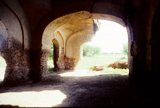 |
|
| |
|
|
|
|
• Gujrat Town and District
Traveling further west, we reach Gujrat, which lies on the right
bank of the Chenab River and marks the intersection between the
Grand Trunk Road and a major road north to Kashmir and its gardens.
Legend has it that two lovers, Sohni and Mahiwal, met each other
across the river here until they were tragically drowned. In addition
to the square fort, walled town, baths, and tombs of Gujrat town,
outlying baradaris at Hafiz Hayat and tombs such as Helan had extensive
garden complexes. An Akbari period garden has been recently identified
just across the Jhelum River near Nandana (Rehman and Wescoat, 1993).
|
|
| |
|
| |
|
| |
• Riwat
The road continues past Rohtas Fort built by Sher Shah Suri in the
mid-16th century, through the deeply eroded Potwar Plateau, until
one passes by the encampment and tomb-complex of Sultan Sarang at
Riwat. Although not a Mughal site or garden, as such, this enclosure
incorporates garden elements in its layout.
|
|
Fortified
Palace at Riwat |
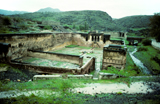 |
|
|
|
|
|
• Wah Garden
Just beyond modern Islamabad and not far from the Buddhist city
of Taxila, lies the extraordinary Mughal garden known as “Wah!”
|
|
|
|
Wah
Garden |
 |
|
|
|
| See Wah Garden Web Page |
|
|
|
|
Attock
Fort on the Indus River |
 |
|
|
|
|
• Attock
The Grand Trunk Road meets the Indus River at the historic crossing
of Attock. Here Akbar built a large fort on the left bank of the
river with a water gate on the floodplain below and a ferry that
had to contend with dangerous whirlpools. A hammam (public bath)
had a tunnel to the fort gate, and a caravanserai (traveler’s
rest stop) north of the fort has a garden-like layout.
|
|
Caravanserai
at Attock Fort |
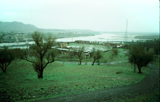 |
|
|
|
|
|
|
|
|
Vallai
Terrace Garden |
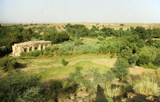 |
|
|
|
|
|
• Vallai
A surprisingly secreted site exists near the village of Vallai,
outside of the city of Nowshera in the Northwest Frontier Province.
Also known as Rang Mahal (“Painted Palace”) for its
decorated central structure, this complex had a spring-fed tank
that channeled water through a formal garden. Built in the late
seventeenth century, this garden has many of the spatial elements
found at Wah Garden.
|
|
|
|
Vallai
Garden Pavilion |
 |
|
|
|
|
|
|
|
|
Sayyid
ka Bagh Complex in Peshawar |
 |
|
|
|
|
•
Peshawar
The city of Peshawar has ancient origins on account of its location
in an irrigated valley favorable to both commerce and cultivation.
It has some ten famous gardens dating from the Mughal period to
the early nineteenth century, all of which have little-known histories
and mixtures of Mughal and other sources. Only the four below survive
to any substantial degree today. |
|
| |
|
|
|
|
Central
Tomb of Sayyid ka Bagh |
 |
|
|
|
|
| Sayyid
ka Bagh, the “Garden of the Sayyid,” lies west
of the old city of Peshawar. It has a beautiful structure but uncertain
history. Attributed to Nawab Sayyid Khan, a Mughal governor of Kabul
several times during Shah Jahan’s reign who died there in
1651, it has a lovely masonry tomb set on a brick-paved plinth,
surmounted by the only extant double dome in Peshawar. It is surrounded
by a garden whose boundaries and layout extended to include the
Dabgari gardens but are now lost. Indeed, even the identity of this
Mughal tomb-garden is obscured by its conversion to a colonial residence,
then a Christian mission church, and now a hospital. Even so, it
stands as the most “Mughal” of the surviving gardens
in Peshawar. |
|
|
|
|
|
|
Heavily
Renovated Shahi Bagh |
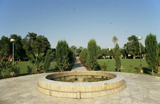 |
|
|
|
|
| Shahi
or Shalamar Bagh. The garden known today as Shahi
Bagh, or King’s Garden, formerly extended into what is now
the Jinnah Bagh on the northern outskirts of Peshawar. Interestingly,
it was earlier called Shalamar garden and attributed to the Mughal
governor Ali Mardan Khan, as were gardens later given that name
in Lahore, Delhi, and Srinagar. The British officer Elphinstone
described its elaborate terraces, fountains, and plantings in the
early nineteenth century. Traces of its rectangular, symmetrical
layout survive, but it has suffered from destruction and heavy-handed
restorations over the past two centuries. |
|
| |
|
|
|
|
| |
Another
Garden of Ali Mardan Khan. Perhaps his Persian origin accounts
for the many stories of Ali Mardan Khan’s celebrated role
in garden and canal-building during Shah Jahan’s reign. However,
he spent considerable time in Qandahar before defecting to the Mughals,
and later as governor of Kabul. His garden in the far western suburbs
of Peshawar had a three-story building but went through many transformations
to become a “company bagh,” due to its proximity to
the British cantonment. |
|
|
|
|
Wazir
Bagh |
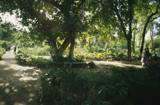 |
|
|
Wazir
Bagh. The last famous surviving historic garden of Peshawar
is known as the Wazir or royal advisor’s garden. Begun in
1802 by Fateh Khan, it postdates the Mughal period by several
decades, but it emulated many of their qualities of axial waterways
and layout characteristic of late-Mughal gardens. It, too, has
been frequently and heavily restored.
|
|
References (Lahore to Peshawar)
Dani, A.H. 1969. Peshawar, historic city of the frontier.
Peshawar: Khyber Mail Press.
Moorcroft, W.,G. Trebeck, H. H. Wilson, and others. 1841-2000.
Travels in India: Himalayan provinces of Hindustan and the
Punjab, in Ladakh and Kashmir, in Peshawar, Kabul, Kunduz and
Bokhara: From 1819 to 1825. New Delhi: Low Price Publications.
Rehman, A. 1996. The gardens of Peshawar. In The Mughal garden:
Interpretation, conservation and implications. Ed. M. Hussain,
A. Rehman, and J.L. Wescoat, Jr. Lahore: Ferozsons, pp. 89-92.
Rehman, Abdul. 2002. Historic towns of Punjab. Lahore: Ferozsons.
Rehman, Abdul and J.L. Wescoat, Jr. 1993. Pivot of the Punjab:
The historical geography of medieval Gujrat. Lahore: Dost.
Shakirullah. Rang Mahal at Valai. Journal of Central Asia
18, no. 1 (July 1995): pp. 127-133.

|
|
Wazir
Bagh |
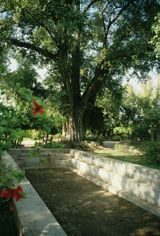 |
|
|
|
|
|
| |
|
|
| |
The Ancient Southern Road from Lahore to Multan |
|
|
|
|
Ravi
River Floodplain at Shahdara |
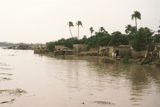 |
|
|
While
the Grand Trunk Road was, and is, a great artery of commerce across
northern Pakistan and India, the road from Lahore south to Multan
takes one back through pre-Mughal eras and centers of history. The
Web page on Lahore and Its Garden
Suburbs has already introduced the gardens of Anarkali, the
Chauburji, and Zebunnisa on the south side of Lahore. Here we continue
south toward the medieval Sultanate capital of Multan. |
|
|
|
The
road along the River Ravi from Lahore to Multan passes through cultivated
floodplains subject to periodic catastrophic inundations that change
the course of the river and fate of river-front landscapes.
|
|
|
|
Poet
Waris Shah’s Tomb |
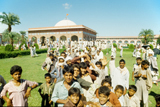 |
|
|
|
| |
|
The
rivers of Punjab have built up layers of settlement, folklore, and
sacred sites. At Jandiala Sher Khan lies the tomb-garden of the
poet-saint Waris Shah, who made the tragic love story of Hir and
Ranjha famous throughout Punjab. Although the garden is modern,
an old stepwell and water system survive.
|
|
|
|
Stepwell
at Waris Shah’s Tomb |
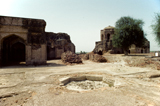 |
|
|
|
| |
|
|
|
|
Site
of Satghara near Okara |
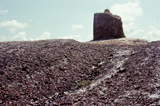 |
|
|
Further
south, some of the surviving medieval sites such as Satgahra lie
on top of vast proto-historic mounds of Harrappan civilization,
which flourished four millennia ago.
|
|
| |
|
|
|
|
Shrine
of Baba Farid at Pakpattan |
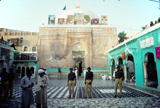 |
|
|
Layers of a different sort occur at the towns of Pakpattan and Dipalpur.
Pakpattan (“the ferry of the pure”) contains the shrine
of the thirteenth-century Sufi saint Baba Farid Ganj-i Shakar. While
it does not have a planted garden, its “paradise gate”
opens once a year for the faithful, who hope that passing through
it will wash away their sins and lead to paradise. Although purposely
chosen for its distance from thoroughfares, it has been a pilgrimage
center from Mughal times to the present.
|
|
|
|
|
|
|
Tomb
Complex of Shaikh Rukn-i Alam |
 |
|
|
• Multan
The city of Multan was renowned in earlier times for its “heat,
dust, and graveyards.” But according to some observers it
also had beautiful gardens. The traveler described Bagh-i Begi during
his stay as “…cool, well-shaded with orange trees and
laid out in the usual manner with reservoirs and fountains. The
walks, intersecting each other at right angles, were raised above
the parterres and flowerbeds, that they might be dry when the latter
are covered with water. There are numerous gardens in the environs
of Multan, often formed around the shrine of some Mussulman faqir”
(Khan, 1983, 331). |
|
| |
|
|
|
|
Tomb
of Shaikh Rukn-i Alam |
 |
|
|
Those
“faqirs” included some of the most famous Surhawardi
Sufis of the medieval period, such as Baha al-Din Zakariya and Shah
Rukn-i Alam. Their tombs, decorated with bands of blue glazed tile,
are located within the fortified citadel, which overlooked green
spaces below. |
|
| |
|
|
|
|
Tomb
of Shams Sabzwari |
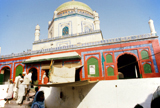 |
|
|
The
tomb of the Ismaili saint Shams Sabzwari lies outside the citadel
not far from agricultural fields and gardens even today. Legend
has it that when Shams Sabzwari arrived in Multan, Shaikh Baha al-Din
Zakaria sent him a cup filled to the brim with milk, to indicate
that Multan did not need him, but Shams Sabzwari returned it with
a rose floating on its surface. Another legend ascribes Multan’s
ferocious heat to a miracle of Shams Sabzwari. |
|
|
|
|
|
|
Qasim
Bagh Public Garden in Multan |
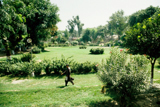 |
|
|
The surviving suburban gardens of Multan, such as the Qasim Bagh
and Bagh-i Langah Khan, have been heavily restored as public parks.
While they still invite speculation about medieval landscape design
and have some parallels with the gardens of Lahore, their paramount
importance today is bringing much-needed shade and recreation. |
|
References
(Lahore to Multan)
Khan, A.N. 1980. Uchchh: History and architecture.
Islamabad: National Institute of Historical and Cultural Research.
Khan, A. N. 1983. Multan: History and architecture. Islamabad:
Islamic University.
Khan, Muhammad Wali Ullah. 1985. Mausoleum of Shaikh Rukn-e
Alam, Multan. Lahore: Department of Auqaf.
Rasool, Niaz, ed. Archaeological sites and monuments in Punjab.
Pakistan Archaeology (special issue), no. 29, (1994-96).
Karachi: Pakistan Department of Archaeology.
Rehman, A. 1997. Historic towns of Punjab: Ancient and medieval
period. Lahore: Ferozsons, pp. 217-36.
|
|
| |
|
|
|
|
 |
|
|